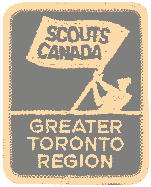
www.gtrsi.com
 |
www.gtrsi.com |
 |
Pioneering |
| Purpose: This Badge recognizes the
ability of a Scout in the area of pioneering. The ability goes beyond the
basic knowledge of knots and lashing to the point that the Scout can create useful and creative items using easily obtained wooden poles and rope (cord, string, etc.)
Requirements: 1) Demonstrate the ability to tie the three (3) knots not covered during the Voyageur Requirements. Know the uses of the knots in a pioneering setting. (i.e. clove hitch for beginning and ending a lashing)
|
Exploring |
| Purpose: Scout to explore an unfamiliar area.
Requirements: 1) Plan, conduct and evaluate three expeditions of increasing challenge; by foot, bike, canoe, etc. Distance and durability to be determined with your Scouter based on personal ability.
|
Winter Scouting |
| Purpose: Demonstrate ability to hike and camp in the outdoors in the winter.
Requirements: 1) Plan and conduct three winter activities, one of which must be an
overnight camp.
|
Weather |
| strong>Purpose: To develop an interest in and skills about weather information.
Requirements: 1. Maintain an interest in weather by recording for a one month
period the following weather data for a specific site:
|
Advanced Tripping |
| Purpose: Demonstrate extended lightweight camping skills by participating in Lightweight Camping, Long Distance
Hiking, or Extended Tripping.
Requirements: 1) Complete twelve (12) nights of camping with at least two (2) three night camping experiences. These must provide the opportunity to demonstrate advanced lightweight skills.
|
Paddling |
| Purpose: Demonstrate the skills and knowledge to safely handle a canoe, kayak or similar craft on flat or slow moving water.
NOTE: You must wear a properly fitted PFD while in a boat. Requirements: Safety 1) Explain safety in, on and around water.
Knowledge 1) Name and point out 10 parts on your craft and 5 paddle parts.
Skills 1) Paddle equally well in bow and stern or, if your craft requires, solo.
|
Powercraft |
| Purpose: To encourage Scouts to practice the safe operation, and be able to demonstrate basic maintenance, of a
powercraft.
NOTE: You must wear a properly fitted PFD while in a boat. Requirements: 1. a) Earn the Canadian Red Cross Society's Power Boating Award.
|
Water Tripping |
| Purpose: Experience all aspects of extended water trips.
Prerequisite: Prerequisite for this badge is the Paddling badge, Sailing badge or Powercraft badge. Requirements: 1) Help in the planning and participate in a three (3) day water trip.
|
White Water |
| Purpose: The safe and responsible handling
of a canoe, kayak or similar craft in moving water.
NOTE: You must wear a properly fitted PFD while in a boat. Pre-requisite: The Paddling badge is a pre-requisite for this badge. Requirements: 1. Describe the effects on the craft of rocker, wind, river current and load positioning (including paddlers).
Suitable Equipment 1. Discuss Provincial regulations on PFD's and demonstrate proper use.
Paddle Strokes
General Knowledge 1. Demonstrate what to do if capsized.
|
Sailing |
| Purpose: Covers sailboats, sailing dinghies
and keelboats.
NOTE: You must wear a properly fitted PFD while in a boat. Requirements: 1. Have at least the Canadian Red Cross Society's Blue or Small Craft Safety Survival Level or the YMCA's Star IV Award, or demonstrate the following:
|
|
Disclaimer: Anything posted to this Home Page
are the opinions of the individuals who posted them and are not the views of Scouts Canada. |